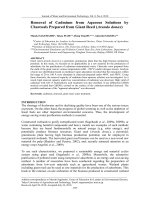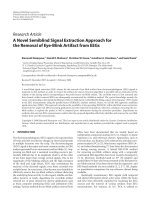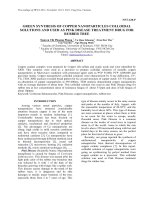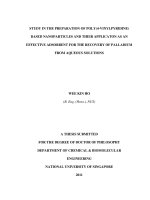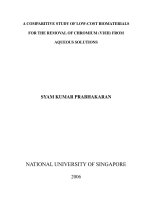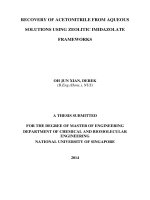Ha, t m t (2020) synthesis of reduced graphene oxide (rgo) for the removal of tetracycline from aqueous solutions master’s thesis, vietnam national university, hanoi
Bạn đang xem bản rút gọn của tài liệu. Xem và tải ngay bản đầy đủ của tài liệu tại đây (2.75 MB, 76 trang )
VIETNAM NATIONAL UNIVERSITY, HANOI
VIETNAM JAPAN UNIVERSITY
HA THI MY TRINH
SYNTHESIS OF REDUCED GRAPHENE
OXIDE (rGO) FOR THE REMOVAL OF
TETRACYCLINE FROM AQUEOUS
SOLUTIONS
MASTER'S THESIS
VIETNAM NATIONAL UNIVERSITY, HANOI
VIETNAM JAPAN UNIVERSITY
HA THI MY TRINH
SYNTHESIS OF REDUCED GRAPHENE
OXIDE (rGO) FOR THE REMOVAL OF
TETRACYCLINE FROM AQUEOUS
SOLUTIONS
MAJOR: ENVIRONMENTAL ENGINEERING
CODE: 8520320.01
RESEARCH SUPERVISORS:
Dr. TRAN DINH TRINH
Dr. NGUYEN THI AN HANG
Hanoi, 2020
ACKNOWLEDGEMENTS
This work could not have been completed without the collaboration and help
of many people whom I want to thank.
First of all, I would also like to extend my deepest gratitude to Dr. Tran Dinh
Trinh, who inspired me to develop invaluable insight into a new field to me. I’m also
deeply indebted to Dr. Nguyen Thi An Hang, who provided me with relentless
support and constructive advices.
Many thanks to Mrs. Dao Thi Huong – the laboratory technician – as well as
staffs of the Master’s Program in Environmental Engineering for all practical
instructions and useful contributions. Thanks also go to my classmates and teammates,
who enthusiastically supported me during this study.
Finally, I cannot begin to express my thanks to my family and friends for their
patience and support until I finished this work.
I’d like to acknowledge the assistance of the staffs from the Academic,
Research and Development Promotion Department of VNU Vietnam Japan
University as well as Japan International Cooperation Agency for guiding and
supporting me to complete my thesis.
Thank you all for everything.
Ha Noi, August 7th, 2020
Student
Ha Thi My Trinh
i
TABLE OF CONTENTS
Acknowledgements .....................................................................................................i
List of figures ............................................................................................................. v
List of tables ..............................................................................................................vi
List of abbreviations ...............................................................................................vii
Introduction ............................................................................................................... 1
Chapter 1. Literature review ................................................................................... 4
1.1. Antibiotics pollution .............................................................................................4
1.1.1. Definition, classification and sources of antibiotics..........................................4
Sources of antibiotics .................................................................................................. 5
Application of antibiotic in human and veterinary dedicines ..................................... 6
1.1.2. Occurrence of antibiotics in water and environmental effects ..........................8
Occurrence of antibiotics in water .............................................................................. 8
Effect of antibiotic residues ........................................................................................ 8
1.1.3. Regulations on antibiotic content in water ........................................................9
1.1.4. Tetracycline pollution in water .......................................................................10
1.2. Technologies of the treatment of antibiotics in water ........................................11
1.2.1. Filtration and sorption processes.....................................................................11
1.2.2. Photodegradation and oxidation......................................................................12
1.2.3. Biodegradation ................................................................................................12
1.2.4. Other techniques..............................................................................................13
1.2.5. Technologies applied for the treatment of TC in water ..................................14
1.3. Synthesis and application of rGO in antibiotic adsorption.................................14
1.3.1. Synthesis of rGO .............................................................................................15
Chemical reduction ................................................................................................... 15
Thermal reduction ..................................................................................................... 15
Solvothermal/hydrothermal reduction ...................................................................... 16
Other methods ........................................................................................................ 16
1.3.2. Application of rGO in antibiotic adsorption ...................................................17
Chapter 2. Materials and methods ........................................................................ 18
ii
2.1. Materials .............................................................................................................18
2.2. Methods ..............................................................................................................18
2.2.1. Literature review .............................................................................................18
2.2.2. Sample analysis in laboratory .........................................................................18
Characterization of materials ....................................................................................18
a) Fourier-transform infrared spectroscopy .............................................................. 18
b) Energy-dispersive X-ray spectroscopy ................................................................. 20
c) Scanning Electron Microscopy ............................................................................. 21
d) X-ray diffraction ................................................................................................... 22
e) Surface area and pore volume calculation ............................................................ 23
f) pH point of zero charge ......................................................................................... 25
Determination of Tetracycline concentration ...........................................................25
2.2.3. Data calculation ...............................................................................................26
a) Removal efficiency ............................................................................................... 26
b) Adsorption capacity .............................................................................................. 26
c) Kinetic parameters ................................................................................................ 27
d) Isotherm parameters .............................................................................................. 27
e) Thermodynamic study........................................................................................... 28
2.2.4. Statistical analysis ...........................................................................................28
2.3. Experiment setup ................................................................................................29
2.3.1. Material synthesis............................................................................................29
2.3.2. Factors influencing the efficiency of TC adsorption ......................................29
a) Contact time ........................................................................................................ 29
b) pH
........................................................................................................ 30
c) Dosage of rGO ...................................................................................................... 30
d) Initial concentration of Tetracycline ..................................................................... 30
2.3.3. Isotherm tests ..................................................................................................30
2.3.4. Kinetics tests ...................................................................................................30
2.3.5. Thermodynamic tests ......................................................................................31
Chapter 3. Results and discussion ......................................................................... 32
3.1. Material characterization ....................................................................................32
iii
3.1.1. Fourier-transform infrared spectroscopy ........................................................32
3.1.2. Energy-dispersive X-ray spectroscopy ...........................................................33
3.1.3. X-ray diffraction..............................................................................................34
3.1.4. Surface area and pore volume .........................................................................35
3.1.5. pH point of zero charge ...................................................................................37
3.2. Adsorption study ................................................................................................38
3.2.1. Factors influencing TC adsorption ..................................................................38
a) Contact time ........................................................................................................ 38
b) pH
........................................................................................................ 39
c) Dosage
........................................................................................................ 40
d) Initial concentration .............................................................................................. 41
e) Temperature ........................................................................................................ 42
3.2.2. Adsorption isotherms ......................................................................................43
3.2.3. Adsorption kinetics .........................................................................................45
3.2.4. Adsorption thermodynamics ...........................................................................46
Conclusions and recommendations ....................................................................... 48
Conclusions ...............................................................................................................48
Recommendations .....................................................................................................48
References ................................................................................................................ 50
Appendix .................................................................................................................. 58
iv
LIST OF FIGURES
Figure 1.1. Pathways of antibiotics into water ...........................................................6
Figure 1.2. Global antibiotic consumption in livestock 2010 ....................................7
Figure 1.3. Legislation on antibiotics as growth promoters .......................................7
Figure 2.1. FT-IR 4600 Jasco ...................................................................................20
Figure 2.2. Principle of EDX measurement .............................................................21
Figure 2.3. JSM-IT100/JED-2300 Analysis Station Plus, JEOL.............................21
Figure 2.4. MiniFlex 600..........................................................................................23
Figure 2.5. TriStar II Plus, Micromeritics ................................................................25
Figure 2.6. Calibration curve for Tetracycline .........................................................26
Figure 3.1. FT-IR result comparison of GO and rGO ..............................................32
Figure 3.2. SEM images of (a) graphite and (b) rGO ..............................................33
Figure 3.3. XRD results of GO and rGO .................................................................35
Figure 3.4. (a) N2 adsorption and desorption isotherms, (b) Types of physisorption
isotherms, and (c) Types of hysteresis loops (IUPAC).............................................36
Figure 3.5. Pore size distribution of rGO obtained from DFT method ....................36
Figure 3.6. The plot of ΔpH versus pHi ...................................................................38
Figure 3.7. Effect of contact time on TC adsorption by rGO ..................................39
Figure 3.8. Effect of pH on TC adsorption by rGO .................................................40
Figure 3.9. Effect of dosage effect on TC adsorption by rGO .................................41
Figure 3.10. Effect of initial concentration on TC adsorption by rGO ....................42
Figure 3.11. Effect of temperature on TC adsorption capacity of TC of rGO .........43
Figure 3.12. Comparison of experimental data and modeled data on adsorption
isotherms ...................................................................................................................43
Figure 3.13. Plot of ΔG0 against temperature (K) ....................................................46
v
LIST OF TABLES
Table 1.1. Antibiotics classification according to chemical structure........................4
Table 1.2. Chemical properties of tetracycline.........................................................10
Table 3.1. IR Spectrum by frequency range .............................................................33
Table 3.2. C/O ratio comparison of GO and rGO ....................................................34
Table 3.3. Properties of materials used for TC removal in previous studies ...........37
Table 3.4. Langmuir and Freundlich isotherm parameters on TC adsorption .........44
Table 3.5. First- and Second-order kinetic parameters for TC adsorption ...............45
Table 3.6. Thermodynamic parameters of TC sorption process by rGO .................47
Table S1. Antibiotic Resistance Alliance Science-Based PNEC Targets for Risk
Assessments ..............................................................................................................58
Table S2. Removal of tetracycline antibiotics using different treatment processes 65
vi
LIST OF ABBREVIATIONS
BJH
Barrett-Joyner-Halenda method
DFT
Density Functional Theory
EDA
Electron donor-acceptor
EDX
Energy-dispersive X-ray spectroscopy
FT-IR
Fourier-transform infrared spectroscopy
GO
Graphene oxide
IUPAC
International Union of Pure and Applied Chemistry
pHpzc
Point of zero charge
rGO
Reduced graphene oxide
SEM
Scanning electron microscopy
TC
Tetracycline
WWTPs
Wastewater treatment plants
XRD
The X-ray diffraction
vii
INTRODUCTION
Since its discovery in 1928, antibiotics have played a very important role in
human health protection and livestock industry. It is estimated that millions of people
have been saved from bacterial diseases (smallpox, cholera, typhoid fever, syphilis,
etc.) thanks to antibiotics. Antibiotics have revolutionized the treatment of bacterial
diseases, which probably increase the average life span of Americans from 47 years
in the early 20th century to 78.8 years (Chain et al. 2016). Antibiotics are also widely
known as growth stimulant in fisheries, livestock and cultivation.
However, besides the great health and economic benefits, antibiotics are also
associated with negatively potential risks to humans and ecosystems. Antibiotics
were considered a persistent or “pseudo-persistent” substances because its speed of
entering the environment is faster than that of its decomposition (Gothwal and
Shashidhar, 2015), thus causing harms to the ecosystem. One of the biggest problems
was antibiotic resistance, which means bacteria were resistant to antibiotics that they
are sensitive to. Antibiotic abuse behavior and antibiotic production activities created
an environment with sub optimal antibiotics (a dose sufficient to kill bacteria) that
helped "train" bacteria that develop antibiotic-resistant individuals. Many studies
warned the increasing occurrence of antibiotics in the environment (soil, sediment,
groundwater, surface water, waste water). For instance, in China, the concentration
of quinolones in domestic sludges of wastewater treatment plants (WWTPs) was
reported to be up to 29,647μg/kg, and 4,916ng/L in a municipal wastewater
reclamation plant in Beijing (Gothwal and Shashidhar, 2015). In many cases,
antibiotic levels even exceeded concentrations of industrial wastewaters. For example,
effluence of a wastewater treatment plant in India was reported to contain
ciprofloxacin up
to
31 mg/L
(Larsson
et
al.
2007).
However, there are so far very few regulations for antibiotic concentrations in the
water, so that the treatment plants usually do not take this kind of contaminants
seriously.
1
Many studies have been carried out with the purpose of eliminating antibiotics
from environments. The preferred methods used today are: adsorption; degradation
(photo-degradation, catalysis, bio-degradation); and oxidation processes (ozonation,
UV raddiation, ...). In particular, adsorption is a commonly applied method thanks to
its advantages such as high efficiency and ease of operation. Many materials have
been used for adsorption process such as activated carbon (Rivera-Utrilla et al., 2013)
graphene oxide (Gao et al., 2012), activated sludge (Prado et al. 2009). However,
studies showed that these materials are time consumed to reach high efficiency.
Therefore, reducing processing time is one of major approaches to widespread the
application of this method.
Graphene is a single layer of carbon with thickness as a carbon molecule,
dense with carbon molecules containing sp2 in honeycomb lattice (Fitzer, et al. 1995,
Choi et al., 2010; Ray, 2015). Graphene Oxide (GO) and Reduced Graphene Oxide
(rGO) is oxidized graphene and has the presence of epoxy and hydroxyl functional
groups; There were differences in functional groups or C:O ratio (Haubner et al.,
2010). Although the presence of oxygen-containing groups made GO able to be
hydrophilic which is suitable for water treatment, these functional groups weakened
the π-electron activity linked to high fraction of sp3 C atoms which is important
interaction for adsorption process (Ai et al., 2019). On the other hand, rGO with the
large specific surface area (Nidheesh, 2017), significantly fewer functional groups
than GO, and its powder form made it more efficient and economic.
The main objectives of this research are to:
1) Develope rGO as adsorbent for the removal of TC from aqueous solutions.
2) Investigate the effect of pH, adsorbent dose, initial TC concentration, contact time,
and temperature on the adsorption of TC by rGO in the batch experiments.
3) Estimate the TC adsorption capacity and removal efficiency of the as-synthesized
rGO and compare to other adsorbents.
4) Elucidate the TC adsorption mechanisms by rGO.
The thesis consists of 4 main chapters as follows:
a) Chapter 1: Literature review: Overviews on antibiotics in the aspects of
classification, current applications in human and veterinary, pollution situation,
2
ecological and environmental impacts, treatment technologies, along with the
synthesis and application of rGO in antibiotic adsorption.
b) Chapter 2: Materials and methods: Describes materials, chemicals and methods
utilized for the synthesis, characterization and application of rGO in the
adsorption tests.
c) Chapter 3: Results and discussion: Refers the main research results, including
characterization of rGO, factors influencing the adsorption of TC, adsorption
isotherms, and adsorption kinetics.
d) Chapter 4: Conclusions and recommendations: Summarizes the main findings of
the present study and suggests future perspectives.
3
CHAPTER 1. LITERATURE REVIEW
1.1 Antibiotics pollution
1.1.1. Definition, classification and sources of antibiotics
According to IUPAC, antibiotic is a substance produced by, and obtained from,
certain living cells (especially bacteria, yeasts and moulds), or an equivalent synthetic
substance, which is biostatic or biocidal at low concentrations to some other form of
life, especially pathogenic or noxious organisms (Duffus, 2007).
Antibiotics can be classified based on their chemical structure, action
mechanism, action spectrum, and the route of administration (Gothwal and
Shashidhar, 2015). For further study of kinetics and mechanism, classification
according to chemical structure is preferred in Table 1.1.
Table 1.1. Antibiotics classification according to chemical structure (Kebede et al.,
2014)
Group
Carbohydrate
antibiotics
Macro cyclic
lactone (lactam)
antibiotics
Representative with practical
importance
Internal group
1.Aminoglycosideantibiotics
2. Other (N- and C-)
glycosides
1.Macrolide antibiotics
2.Polyeneantibiotics
3. Macrolactam antibiotics
Quinone and
similar antibiotics
Erythromycin
Amphotericin
Oligomycin
Tetracyclines, Penicillins,
Cephalosporins,
Amino acid
Peptide antibiotics
Oxygen-containing
Heterocyclic
antibiotics
Streptomycin, Neomycin
Bacitracin, Polymyxins
1.Non-condensed(single)
heterocycles
2.Condensed (fused)
heterocycles
4
1.Furan derivatives
2.Pyran derivatives
Alicyclic
antibiotics
1.Cycloalkane derivatives
2.Small terpenes
Streptovitacins
3.Oligoterpene antibiotics
1.Benzene compounds
Aromatic
antibiotics
Aliphatic
antibiotics
2.Condensedaromatic comp.
3.Non-benzene aromatic
comp.
Chloramphenicol
Grisefulvin
Novobiocin
1.Alkane derivatives
2.Aliphatic carbocyclic acid
derivatives
Sources of antibiotics
Varitin
Antibiotics mostly demonstrated degradation performance <30% over 7 days,
except of tetracycline is <44% over 7 days. (Wilkinson et al. 2019). Tetracycline is
relatively inert within human body (Hirsch et al., 1999). Then, remaining antibiotic
in environment would become long-term contaminants and accumulate in biomass.
Antibiotic residues enter the environment primarily through human and animal waste
and from manufacturing (Gelband and Miller-petrie, 2016). Antibiotics used in
human and veterinary care are excreted which sometimes are used as agricultural
fertilizer, most of times are discharged to environment. Up to 90% of antibiotic dose
can be excreted in animal urine and up to 75% in their feces. Combined with expired
industrial drugs, all of un-used antibiotic go into WWTPs and landfill. Several studies
reported that conventional treatment techniques cannot remove these persistent
compounds completely, therefore significant amounts enter the aqueous environment,
and end up to be influent of water treatment plants with inefficient treatment
techniques.
5
Figure 1.1. Pathways of antibiotics into water (modified from Frade et al. 2014)
Application of antibiotic in human and veterinary dedicines
Ever since antibiotics has been discovered, their market has been massively
grown. They have been extensively and effectively used in human and veterinary
medicines and their benefits have also been recognized in agriculture, aquaculture,
bee-keeping, and livestock as growth promoters (Gothwal and Shashidhar, 2015).
But over-use of these chemical compounds for both human and veteran care
were attending concern due to its consequence. Antibiotic use in humans was
increasing worldwide for first-line and some last-resort antibiotics. Only about 20%
was used in hospitals, and non-prescription use of antibiotics is approximated 90%
outside USA and Europe. High-income countries tend to had higher in consumption
in per capita, but low and middle income countries had the greater increase in
antibiotic use. (Gelband and Miller-petrie, 2016).
Although antimicrobial consumption for human care was general decreased in
2018-2019 in EU (European Centre for Disease Prevention and Control, 2019),
expanding use antimicrobials in livestock, one of consequences of increased meat
demanding, is global trend. With estimated 80 percent of all antibiotics consumed in
the United States are used in food animals (Gelband and Miller-petrie, 2016). As Van
Boeckel et al. estimated global consumption of antimicrobials in food animal
production was 63,151 (±1,560) tons in 2010, doubled in 2013 (~131.109 tons) and
projected to reach 200,235 tons by 2030 (Van Boeckel et al., 2017, 2015).
6
Figure 1.1. Global antibiotic consumption in livestock 2010 (Van Boeckel et al.,
2015)
Figure 1.3. Legislation on antibiotics as growth promoters illustrated according to
(Organization for Economic Co-operation and Development, 2015)
China, USA, India and Brazil were estimated to be top 4 countries in term of
the most antibiotics consumption in livestock in 2010 and 2030, as well as largest
increasing in antibiotic consumption. Interestingly, comparing between Figure 1.2
antibiotic consumption and Figure 1.3 legislation on antibiotics as growth promoters,
regions with highest antibiotic use in animal husbandry include all four difference
legislation areas: ban, partial ban, voluntary withdrawal, and no ban. This raises the
question of effectiveness of the current solutions on policy of limiting the use of
antibiotics.
7
1.1.2
Occurrence of antibiotics in water and environmental effects
Occurrence of antibiotics in water
Aus der Beek et al. (2016) collected data of more than 1000 publications about
pharmaceutical concentrations and found out that pharmaceuticals in the environment
is truly topic of global concern when it detected in 71 countries all around the world.
According to Bu et al. (2013), sulfonamides, fluoroquinolones, macrolides,
tetracyclines and other antibiotics were detected in surface water, rivers, sea waters
and sediments with concentrations mostly at the level of µg/L up to dozens of µL.
They implied that the concentration of these contaminants is related with high
population density cities. Some extremely high concentrations were found in certain
areas indicating local point sources or inefficiency of WWTPs to remove these
contaminants in sewage (Bu et al., 2013). (David, 2017) reported presence of 18
pharmaceuticals in surface waters in lower Great Lakes with highest concentrations
were noted at 0.79µg/L (ibuprofen), 0.55µg/L (naproxen), and 0.65µg/L
(carbamazepine). This review also said that in Grand River watershed, southern
Ontario, 14 in 28 surveyed pharmaceuticals were detected with highest
concentrations belonged to monensin and sufamethazine which are used for livestock.
In Tinkers Creek, 12 antibiotics were detected at 18 upstream and downstream from
WWTP discharges to the mainstream. In summarizing, pharmaceutical compounds
are most detected near the discharge of WWTPs or agricultural production, in less
diluted water bodies. Wilkinson et al. (2019) were detected 31 active pharmaceutical
ingredients including antibiotics in tap, surface, wastewater treatment plant (WWTP)
influent and WWTP effluent water collected globally.
The statistics show that the more regions surveyed, such as Europe, USA,
China, the more antibiotic contaminations are detected, also meaning that the less
surveyed areas, like low- and middle-income countries are less contamination, but it
is data limitations.
Effect of antibiotic residues
Previous studies revealed that some pharmaceutical compounds have
concentrations in the range of chronic and acute toxicity in ecosystem.
8
There are reports about near-extinct vultures due to feeding by dead drug treated
livestock (Oaks et al., 2004). In aquatic, diclofenac is suspected of causing damage
to viscera of the rainbow trout (Triebskorn et al., 2007). 17α-ethynylestradiol at 56ng/L is the reason for collapse population of fathead minnow (Pimephales promelas)
in a male fish feminization experiment in Canada (Kidd et al., 2007).
The widespread of antimicrobials use has created selection pressure, promote
the process of formation and spread of antimicrobial resistant pathogens worldwide.
Resistant microbes and resistance genes can come forth and back between human,
animals, food, water and the environment. antibiotic resistance genes formed in
animals due to growth stimulation can be transferred directly to humans via food
route or indirectly through the environment. It is estimated that about 33,000 death
each year from drug-resistant bacteria in the EU-EEA (European Centre for Disease
Prevention and Control, 2019). Resistant strain, H58, originated in Asia and Africa
was increased from 7% to 97% prevalence rate in 5 years. The resistance rates and
trends are becoming global concerning. 77% of E. faecium healthcare-associated
infections in the United States were resistant to vancomycin (Lahsoune et al., 2007).
Among of high-income countries, United States was reported having higher rates of
resistance to many Gram- positive bacteria, while resistance rates of Gram-negative
bacteria were high in Southern and Eastern Europe. In Asia, median resistance of K.
pneumoniae to ampicillin was 94%, and to cephalosporins, 84%, these contaminants
in Africa was 100 and 50%, respectively. Multi-resistance appeared in 30% of strains
in Asia and 75% of strains in Africa (Gelband and Miller-petrie, 2016).
Antibiotic-resistant infections also contribute to the financial burden on
healthcare systems. Europe cost an estimated €1.5 billion annually, including
healthcare expenditures and productivity losses (America and America, 2009); as
United States is as much as $20 billion, and productivity losses total another $35
billion (Lahsoune et al., 2007).
1.1.3 Regulations on antibiotic content in water
At the present, EU and South Korea are only regions have completely banned
the use of antibiotics as growth promoters, but EU is still one of the regions using
9
most antibiotics for animal husbandry. The reason is the large part of antibiotics are
overlapping between use of disease prevention and growth promoters. Due to limited
quantitative data, toxicity assessments for antibiotics cannot lead to a standard of
legal concentration in the environment, just Predicted No Effect Environmental
Concentration (PNEC) (Table S1) values have been suggested as maximum levels in
an environmental matrix.
1.1.4 Tetracycline pollution in water
Tetracycline antibiotics are one of the primarily antibiotics groups used for
veterinary purposes, for human therapy and in agriculture sector as feed additive
(Daghrir and Drogui, 2013). According to (Xie et al. 2010; Cheng et al. 2005) show
that tetracycline antibiotics are ranked second in the production and usage of
antibiotics worldwide and are ranked first in China. Tetracycline, one of three most
commonly used in the tetracyclines, showed that they are high water solubility
(0.041mg/L) and low volatility (low log KOW). Physic-chemical properties of
tetracycline are listed in Table 1.2. Therefore, these antibiotics likely stay persistence
in the aquatic environment. Removal efficiency of conventional wastewater treatment
plant was range from 12% to 80% (Daghrir and Drogui, 2013).
Table 1.2. Chemical properties of tetracycline (Rivera-Utrilla et al., 2013)
Volume
nm
Cross
area
Solubility
Log
g/L
KOW
Chemical Structure
3
nm2
pKa
3.32
0.403
3.969
22
-1.3
7.78
9.58
Tetracycline was detected at median 0.151µg/L and maximum 0.977µg/L in
wastewater treatment plants in 5 cities of Canada (Miao et al., 2004). Is was also
10
tracked in municipal waste water treatment plants effluence samples, in the
concentration range of 280 to 540 ng/l in Tehran, Iran (Javid et al., 2016).
Ecological risk and potential toxic effects of tetracycline antibiotics residues
in the environment also paid attention. As many antibiotics, their residues in
environment promoted the formation and the development of antibiotic resistant
microorganisms. These antimicrobial agents may disturb the microflora of the human
intestinal and increase the risk of certain infections (Heuer et al., 2009).
1.2 Technologies of the treatment of antibiotics in water
Techniques that based on physical reactions (sedimentation, scour/resuspension, adsorption/desorption, and gas transfer), biological transformations
(biodegradation and co-metabolism), and chemical reactions (hydrolysis, oxidation,
photo-degradation) play a important role in water treatment plants. But as Gothwal
and Shashidhar (2015) reviewed, removal efficiencies of conventional sewage
treatment are found to vary substantially due to not designed to deal with new
pollutants like antibiotics.
1.2.1 Filtration and sorption processes
Several studies reported that membrane processes like a reverse osmosisultrafiltration system can reach ≈ 87.5 % efficiency in remove oxytetracycline from
pharmaceutical wastewater (Li et al. 2004) and 50~80% tetracyclines in synthesis
water by nanofiltration (Koyuncu et al., 2008). But these studies also warned that
high concentrations of organic substances present in the environment would hinder
treatment performance.
In sorption process, the contaminant is transferred from liquid phase to solid
phase. A number of materials were applied to remove antibiotics, like activated
carbon, clays, carbon nanotubes, ion exchange, sewage sludge, and waste oil sludgederived adsorbents (Daghrir and Drogui, 2013; Gothwal and Shashidhar, 2015).
Accordingly, the sorption of antibiotics onto soils reached equilibrium in few hours
and was significantly dependent on various factors (pH, organic matter, and mineral
content in soil) and behavior of antibiotic (molecular structure, functional groups).
11
Sorption processes had high removal rate in synthesis water (up to 94%) while hardly
exceeded 67% in real river water (Choi et al., 2008). Hence, this process was also
interfered by organic matter in the same way as that in the filtration process, which
has been aforementioned.
1.2.2 Photodegradation and oxidation
Photolysis processes using light are simple, clean and less expensive. Some
antibiotics, which are sensitive with UV irradiations like tetracyclines, can be
degraded at the rate of up to 90%. Although some studies indicated the presence of
intermediate compounds which can be more toxic than original one (Daghrir and
Drogui, 2013). In the photodegradation process, parameters such as light source, pH,
temperature, time, type of matrix, and the type/amount of impurities in the matrix
(salts, organic compounds, soils, etc.) are important. In addition, maintenance and
electrical cost are usually considered as limiting factors.
The process of oxidation involves the use of strong oxidizing agent such as
hydroxyl radicals, ozone, potassium permanganate, and chlorine. Advanced
oxidation processes which enhance the formation of strong oxidant like free radicals
are attracting attention from many projects. Treatment efficiencies often reach 90%
in an extremely short time with a dosage material in mg/L. Some wise used oxidation
techniques is ozonation, chlorination, Fenton system. Most of the studies are lack of
information
on
by-products
which
formed
during
process.
Belongs on the minority, Li et al. (2008) indicated that the first by-product of
oxytetracycline was more toxic than the parent compound after ozonation. It is
possible by-products can be ecotoxic, and operation and optimization of oxidation
process should be monitor through toxicity tests and determining transformation
products.
1.2.3 Biodegradation
The biodegradation of antibiotics by bacteria were rarely reported. Alexy et al.
(2004) have been assessed of degradation of 18 antibiotics in the Closed Bottle Test,
result is only a few were slightly degraded in 28 days, with the highest rate at 27% is
12
Benzylpenicillin. Those antibiotic also was only compound can be biodegradation up
to 87% of ThCO2 degradation in combined test (Gartiser et al., 2007). Many
antimicrobials reported that can not be biodegradable or negligible biodegradable by
bacteria. On the other hand, degradation of antibiotics by fungus show a more delight
result. Studying in Trametes versicolor, Rodríguez-Rodríguez et al. (2012) reported
that Sulfapyridine was completely degraded, and sulfathiazole reach 88% after 96h
incubation. 72h hydraulic retention time successfully eliminated sulfapyridine,
sulfamethazine and sulfathiazole in a mixture and their metabolites.
1.2.4 Other techniques
Some common water treatment processes were evaluated for antibiotics
removal by Adams et al. (2002), included metal salt coagulation, excess lime/soda
ash softening, powdered activated carbon sorption, ultraviolet photolysis, ion
exchange, and reverse osmosis. The results demonstrated that metal salt coagulation,
excess lime/soda ash softening, ultraviolet photolysis, and ion exchange were not
effective for antibiotic removal; powdered activated carbon sorption and reverse
osmosis could be used to these compounds, but it only available at selected water
treatment plants. Conventional biological wastewater treatment processes were
reported that it was effective for the removal of some antibiotics, but 101000 ng/L concentrations in secondary treated effluents were occurred. Application
of advanced treatment after conventional biological improved the removal of
antibiotics, but operation and maintenance cost goes up (Le-Minh et al., 2010).
In conclusion, filtration and sorption provided high efficiency and economy in
antibiotic removal, but do not destroy the pollutants but transfer it to another phase.
Photodegradation and oxidation recently proposed as alternative methods for
elimination of persistent compounds due to highly degradation rate in shorter time
while use very dosage of materials. But it raised a caution about by-products which
have limited information. Biodegradation is favorable in term of economy and
environmentally, but rarely applied for antibiotic treatment.
13
1.2.5 Technologies applied for the treatment of TC in water
Many treatments of tetracycline antibiotics in waters were suggested, included
photocatalysis, oxidation, Fenton, adsorption, filtration, gamma radiation (table S2).
Adsorption, most wised used in conventional wastewater treatment plants, was
reported in previous studies that it was not so effective for TC removal. Choi et al.
(2008) studied about adsorption using granular activated carbon in combination with
coagulation process for TC antibiotics removal. The results showed that removal rate
of tetracyclines could be up to 94 % from synthetic water, whereas did not exceed
67 % from river water . Rivera-Utrilla et al. (2013) reported about TC removal by
activated carbons, which reached 375.4 mg/g adsorption capacity calculating by
Langmuir model, whereas it took about 200h to achieve equilibrium. Graphene oxide
was reported that the maximum adsorption capacity calculated by Langmuir model
could be reach 313 mg/g (Gao et al., 2012), but the materials could not be recoverable.
Therefore, the material that improved in adsorption capacity while reducing contact
time and being able to recovery was necessary to widely apply adsorption technique
in large-scale for TC removal.
1.3 Synthesis and application of rGO in antibiotic adsorption
Carbon-based materials always preferred in various fields due to their easy
accessibility, hardness, and its ability to exist in various dimensions (Nidheesh, 2017).
Graphene, nano-carbon material, is an promising material with many outstanding
properties. Graphene oxide (GO), a particular branch of graphene material, was
recognized by properties which go along with the presence of several functional
groups like epoxy, hydroxyl, carboxyl in the surface. Obtained from either bottomup or top-down approaches, GO consisted exfoliated multi graphene sheets, then
possess extremely high theory surface area which is an advantage for sorption
technique. Several polar functional groups in surface help GO very hydrophilic, but
causing it is difficult for revoking after using. In addition, electrically insulating
character also occurred in result of these groups. Therefore, reduced of graphene
oxide (rGO) which has relatively surface area with less surface groups could be more
favorable due to recoverability.
14
1.3.1 Synthesis of rGO
GO reduction methods included chemical reduction, thermal reduction,
solvothermal/hydrothermal reduction, microwave and photo reduction, and photo
catalyst reduction (Nidheesh, 2017). Confirmation of effective reduction process are
characterized by Scanning electron microscopy (SEM), Energy-dispersive X-ray
spectroscopy (EDX), Fourier-transform infrared spectroscopy (FT-IR), and X-ray
diffraction (XRD) technique.
Chemical reduction
Chemical reduction is the most popular method to synthesize rGO. GO
dispersion was reduced with reduction agents, oxygen functional groups are
eliminated and the π-electron conjugation within the aromatic ring structure was
partially restored. Investigated reduction agents were L-ascorbic acid, D-glucose, tea
polyphenol (Xu et al., 2015), NaBH4, Hydrazine hydrate (Alibeyli et al. 2017),
borohydrides (Chua and Pumera, 2013), oxalic acid (Song et al. 2012), sodium
hydrosulfite (Zhou et al., 2011). All of these studies reported that rGO have been
synthesized with appropriate characteristics such as C/O ratio, oxygen functional
groups, diffraction peaks. Zhou et al. (2011) studied about synthesis of PVA/graphite
oxide (GO) nanocomposites films by using sodium hydrosulfite as reduction agent.
They included that a 40% increase in tensile strength and 70% improvement in
elongation at break have been obtained with only the addition of 0.7 wt.% of reduced
graphite oxide. The highest conductivity achieved is 8.9× 10 -3 S/m for the composites
containing 3 wt.% rGO, and the conductivity achieved is comparable to those
achieved with hydrazine. Chemical reductions usually propose high reducing
efficiency in a short time.
Thermal reduction
The GO reduced by heating is known as thermal reduction by annealing. This
process is carried out in vacuum, or inert, or reducing atmosphere. The rapid heating
covers the oxygen-containing functional groups on surface to decompose into gases,
thus creates pressure between layers. The heating also increased the volume of gases
stacked between graphene sheets, which lead to exfoliation phenomenon (Singh et al.
15
2016). Li et al. (2009) developed N-doped-rGO sheets through thermal annealing of
GO in ammonia. They concluded that the high temperature is needed to achieve the
better reduction of GO. Schniepp et al. (2006) also reported the similar result, which
the C/O ratio would increase (from <7 to >13) when heating temperature increasing
(<5000C to 7500C). Therefore, this method exhibited the high reduction performance
but it also consumed a lot of energy for heating.
Solvothermal/hydrothermal reduction
Solvothermal or hydrothermal reduction occurs at low temperature and high
pressure inside the sealed container, basically reach supercritical condition of the
solvent which turn into reduction agent. Some solvents were studied is water-NH4OH
(Johra and Jung, 2015), N,N-dimethylformamide (Wang et al., 2009), N-methyl-2pyrrolidinone (Dubin et al. 2014). rGO, which reduced by solvothermal treatment
(1800C at 12h) N,N-dimethylformamide as solvent, was reported that had higher C/O
ratio than chemical reduction by hydrazine reduction at normal pressure (Wang et al.,
2009). On the other hand, reducing GO in N-methyl-2-pyrrolidinone results
confirmed the formation of single sheets of the solvothermal rGO platelet. The
obtained C/O ratio was low, 5.15 at 2000C, and demands 10000C to achieve 6.36
(Dubin et al., 2014). Similar with thermal method, for water treatment, this method
may costly due to required heating in long time.
Other methods
Microwave reduction is wised used as rapid way to product rGO. Using
microwave irradiation to rise instantaneous internal temperature is very effective to
shorten the reaction time and improves efficiency, although it may consume a
massive amount of energy. On the other hand, photo reduction using sunlight,
ultraviolet light, and Krypton fluoride laser provided a additive free, simple, clean,
and flexible approach to reduce GO. But similar with microwave reduction, this
method may costly due to high-energy radiation (Nidheesh, 2017). An alternative
method is microbial reduction, which was report by (Chen et al., 2017) by using
Azotobacter chroococcum, considering an eco-friendly method due to avoid the use
of chemical agents and agglomeration of rGO.
16
